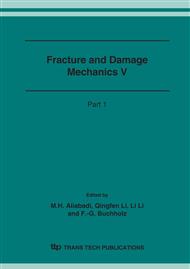p.267
p.271
p.275
p.279
p.283
p.287
p.291
p.295
p.299
Prediction of Cleavage Fracture in the Ductile-to-Brittle Transition Region of Pressure Vessel Steels: A Probabilistic Model
Abstract:
This paper presents a modified Weibull stress model, which accounts for the effects of plastic strain and stress triaxiality at the crack tip region. The proposed model is applied to predict cleavage fracture in a modified A508 pressure vessel steel. It is demonstrated that the Weibull modulus (m) remains constant in the temperature range considered, while the threshold Weibull stress (σw-min) decreases with an increase in temperature due to reduction of the yield stress and the scale parameter of the Weibull model (σu) increases with temperature reflecting the influences of temperature on both material flow properties and toughness. The proposed model accurately predicts the scatter of the measured fracture toughness data and the strong effects of constraint and temperature on cleavage fracture toughness.
Info:
Periodical:
Pages:
283-286
Citation:
Online since:
November 2006
Authors:
Price:
Сopyright:
© 2006 Trans Tech Publications Ltd. All Rights Reserved
Share:
Citation:


